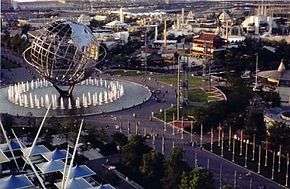Unisphere

Coordinates: 40°44′47″N 73°50′41″W / 40.746426°N 73.844819°W
The Unisphere has a diameter of 120 ft (37 m),[1] spherical stainless steel representation of the Earth. Located in Flushing Meadows–Corona Park (second-largest park in NYC, an area of 1255 acres[1]) in the borough of Queens, New York City. There were two World's Fairs (1939–40, 1964– 65), both largely the inspiration of Robert Moses. Because of the fairs, there were additions of new landscape and one of them is the Unisphere.[1] The Unisphere is one of the borough's most iconic and enduring symbols.
Commissioned to celebrate the beginning of the space age, the Unisphere was conceived and constructed as the theme symbol of the 1964–1965 New York World's Fair. The theme of the World's Fair was "Peace Through Understanding" and the Unisphere represented the theme of global interdependence. It was dedicated to "Man's Achievements on a Shrinking Globe in an Expanding Universe".
Construction


After World War II, Flushing Meadow Park did open after closing for a long time, maintaining landscape architect Gilmore D. Clarke's site plan, as did the 1964– 65 World’s Fair, “Peace through Understanding.[1]” Robert Moses was president of the World’s Fair Corporation, which leased the park from the city and issued $29.8 million in bonds. Unisphere was initially conceptually designed by the landscape architect in aluminum with metallic mesh continents; Unisphere underwent a further refined industrial design in stainless steel by industrial designers at Peter Muller-Munk Associates, and with engineering and fabrication by American Bridge Company, a division of US Steel. It is the world's largest global structure, rising 140 ft (43 m) and weighing 700,000 lb (320,000 kg). Some sources say the Unisphere weighs 900,000 lb (410,000 kg), a figure that includes the additional weight of its 100-ton inverted tripod base. The diameter of the sphere is 120 ft (37 m). It is constructed of Type 304L stainless steel.The continents on the sphere are fabricated with a special texture-pattern by Rigidized Metals Corporation, based in Buffalo, New York.[4] Developed for this architectural project, the pattern's name, “1 UN” stands for: 1 Unisphere.
Built on the structural foundation that supported the Perisphere of the 1939–1940 New York World's Fair, the Unisphere is centered in a large, circular reflecting pool and is surrounded by a series of water-jet fountains. The 96 fountainheads arranged in pairs[5] are designed to obscure its tripod pedestal. The effect is meant to make the Unisphere appear as if it is floating in space.
During the fair, dramatic lighting at night gave the effect of sunrise moving over the surface of the globe. Additionally, the capitals of nations were marked by lights. One of these lights is placed at the location of the Kahnawake Indian Reservation, which the Mohawk ironworkers requested to be placed there to honor their labor.[6]
Three large orbit rings of stainless steel encircle the Unisphere at various angles. These orbit rings are believed to represent the tracks of Yuri Gagarin, the first man in space, John Glenn, the first American to orbit the Earth, and Telstar, the first active communications satellite. In fact, the early design was to have a ring for each of a dozen satellites in place at the time of the Fair. This proved impractical, not only in the number of satellites, but also in the height of their orbits and the fact that geostationary satellites had no orbit path. As a result, a symbolic number of three was chosen for aesthetic reasons.

Rehabilitation
In 1989, the New York City Department of Parks and Recreation announced a multimillion-dollar rehabilitation of Flushing Meadows-Corona Park. Among the projects was a complete restoration of the Unisphere. Begun in late 1993 and completed on May 31, 1994, the project included numerous structural repairs and removal of years' worth of grime accumulation on the steel. The fountains, shut off since the 1970s, were replaced, and new floodlighting installed. On May 10, 1995, the Unisphere was given official landmark status by the New York City Landmarks Preservation Commission.[1]
The Unisphere's fountain reopened on August 12, 2010, after a $2 million restoration of its pumps, valves, and paintwork.[7] In addition, other sites say the globe and its surroundings, including its reflecting pool and fountains, were renovated at a cost of $3 million.[1]
Structural foundation
The marshy soil of Flushing Meadows needed special consideration during the original 1937 Perisphere construction for the 1939 World's Fair. The Perisphere, and subsequently the Unisphere, which used the same platform, employed a foundation of 528 pressure-creosoted Douglas fir piles of 95 to 100 feet (29 to 30 m) in length. Before construction of the Unisphere, three piles were tested for structural integrity and all were found to be sound throughout their entire length.[8]
See also
References
- 1 2 3 4 5 6 The Encyclopedia of New York City (2). New Haven, US: Yale University Press. 2010-01-01. ISBN 9780300182576.
- ↑ "Unisphere (under construction)". NYPL Digital Collections. Retrieved 2016-11-13.
- ↑ "Unisphere, 1960 - Photos - New York: The 1960s". NY Daily News. Retrieved 2016-11-13.
- ↑ Focus on Fabrication - Rigidized Metals, The Architect's Newspaper 5.17.13
- ↑ http://www.nyc.gov/html/lpc/downloads/pdf/reports/unisphere.pdf
- ↑ "Unisphere: Built by US Steel as the symbol of the 1964-5 New York World's Fair", Place Matters, 5 Feb 2010, accessed 11 Jan 2011
- ↑ Hirshon, Nicholas (August 13, 2010). "Fountain's Return". Daily News. New York. Retrieved 2010-09-03.
- ↑ (Creosote) Performance: Proved By More Than 75 Years Service
External links
| Wikimedia Commons has media related to Unisphere. |
- nywf64.com (1964/1965 New York World's Fair Web site) story of Unisphere at the World's Fair
- Unisphere Landmark Designation Report (PDF)
- Unisphere pictures
- Internet Archive: The Unisphere: Biggest World on Earth (1964), film about the creation of the Unisphere
- The Unisphere: Biggest World on Earth on Cinemaniacal
- Internet Archive: New York World's Fair, 1964/03/02 (1964), newsreel featuring the Unisphere.
